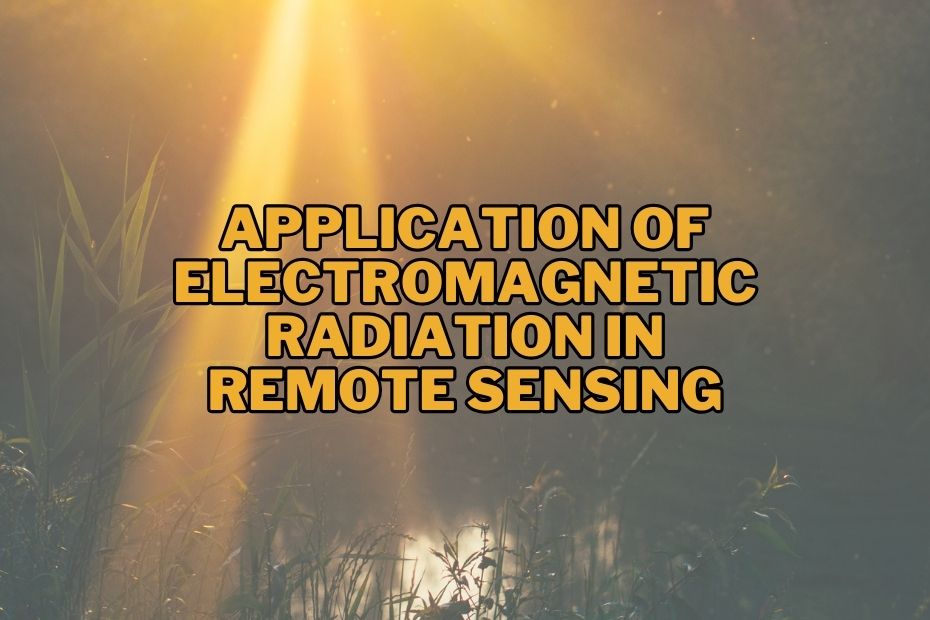Electromagnetic radiation (EMR) plays a pivotal role in the world of remote sensing. Remote sensing, in essence, is the science of obtaining information about objects or areas from a distance, typically from aircraft or satellites. EMR serves as the medium through which we gather this information. In this article, we will delve deep into ten fascinating application of electromagnetic radiation in remote sensing.
Electromagnetic radiation plays a pivotal role in remote sensing, enabling the capture of data about Earth’s surface without direct contact. It works by detecting the reflected or emitted energy from objects, often from satellites or aircraft.
Application of Electromagnetic Radiation In Remote Sensing
Electromagnetic radiation, a cornerstone of remote sensing, has paved the way for numerous applications. Let’s embark on a journey to explore these applications in detail.
1. Land Cover Mapping
One of the primary uses of EMR in remote sensing is for land cover mapping. With this, we can classify and categorize different types of terrain, from forests and urban areas to agricultural lands. This is instrumental in understanding habitat changes and land use. This information is invaluable for urban planning, environmental conservation, and natural resource management. It aids in monitoring changes in land use, deforestation, urban expansion, and much more.
2. Weather Forecasting
The accurate prediction of weather patterns is essential for various sectors, including agriculture, transportation, and disaster management. Remote sensing provides crucial data for weather forecasting by measuring temperature, humidity, cloud cover, and wind patterns from space. This information aids meteorologists in making more precise predictions, thus enhancing our ability to prepare for and respond to weather-related events.
3. Oceanography and Marine Studies
Remote sensing has a profound impact on the field of oceanography and marine studies. By utilizing specialized sensors that can penetrate water, researchers can monitor sea surface temperatures, detect harmful algal blooms, and track ocean currents. These insights are vital for understanding climate change, managing fisheries, and conserving marine ecosystems.
4. Agricultural Monitoring
In agriculture, knowledge is power, and remote sensing provides farmers and agricultural experts with a wealth of information. Agricultural monitoring utilizes satellite imagery to assess crop health, soil moisture levels, and pest infestations. This data aids in optimizing farming practices, increasing crop yields, and ensuring food security.
5. Disaster Management
When natural disasters strike, time is of the essence. Remote sensing technology plays a crucial role in disaster management by providing real-time information on events such as earthquakes, floods, and wildfires. This data aids in disaster preparedness, response, and recovery efforts, potentially saving lives and minimizing damage.
6. Mineral Exploration
The search for valuable mineral resources often requires extensive exploration efforts. Remote sensing technology offers a cost-effective and efficient means of mineral exploration. By analyzing spectral data from satellites and aircraft, geologists can identify mineral deposits beneath the Earth’s surface, facilitating responsible resource extraction.
7. Environmental Monitoring
Maintaining the health of our ecosystems is vital for the well-being of our planet. Environmental monitoring through remote sensing allows us to track changes in vegetation, water quality, and air pollution. This data is instrumental in supporting conservation efforts and informing environmental policies.
8. Urban Planning and Infrastructure Development
In an increasingly urbanized world, effective urban planning and infrastructure development are essential. Remote sensing provides city planners with detailed information on land use, traffic patterns, and population density. This data informs decisions regarding transportation systems, housing development, and disaster preparedness in urban areas.
9. Archaeological Exploration
Unlocking the secrets of our past often requires extensive excavation and research. Remote sensing aids in archaeological exploration by identifying buried structures, ancient roads, and archaeological sites from above. This non-invasive approach minimizes the risk of damage to historical treasures and accelerates the pace of discovery.
10. Military Surveillance
In the realm of national security, remote sensing technology plays a vital role in military surveillance. Satellites equipped with advanced sensors provide governments with valuable intelligence on troop movements, military installations, and potential threats. This information is crucial for strategic planning and maintaining global stability.
11. Space Exploration
Beyond Earth, remote sensing extends its reach to space exploration. Satellites and spacecraft equipped with remote sensing instruments allow scientists to study distant celestial bodies, such as planets, moons, and asteroids. This technology enables us to unlock the mysteries of the cosmos and broaden our understanding of the universe.
As we’ve explored, the applications of remote sensing powered by electromagnetic radiation are incredibly diverse and far-reaching. This technology continues to evolve, pushing the boundaries of what we can discover and achieve. From monitoring our planet’s health to venturing into the depths of space, remote sensing shapes our world in countless ways.
Conclusion:
In conclusion, the application of electromagnetic radiation in remote sensing is a testament to human ingenuity and innovation. This powerful technology has transformed our ability to gather data, make informed decisions, and safeguard our planet and beyond. As we move forward, the potential for remote sensing to revolutionize even more industries and expand our understanding of the universe is limitless.
FAQs: Application of Electromagnetic Radiation In Remote Sensing
Can remote sensing technology be used in space exploration?
Yes, remote sensing technology is instrumental in space exploration. Satellites and spacecraft equipped with remote sensing instruments enable scientists to study distant celestial bodies, map their surfaces, and gather valuable data for scientific research and space missions.
What is electromagnetic radiation in remote sensing?
It’s the use of EMR to observe and measure objects from a distance, typically via aircraft or satellites.
How does EMR assist in space exploration?
It helps in studying celestial bodies, mapping unknown planets, and the quest for extraterrestrial life.
Can remote sensing track underwater life?
Yes, EMR’s ability to penetrate waters enables us to track marine life and study oceanic terrains.
